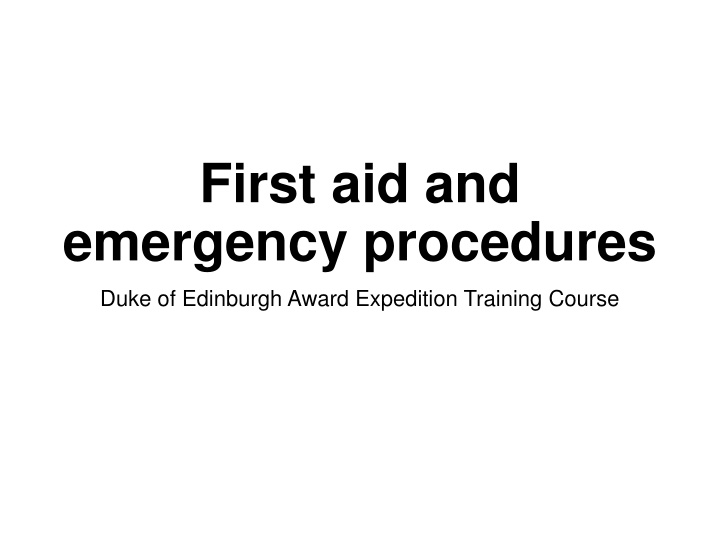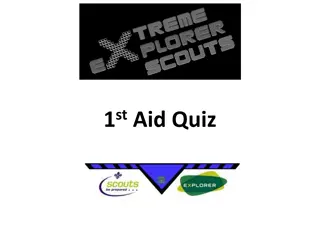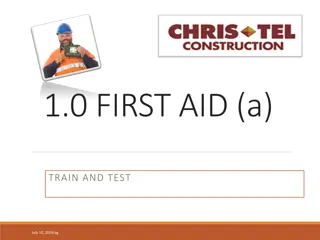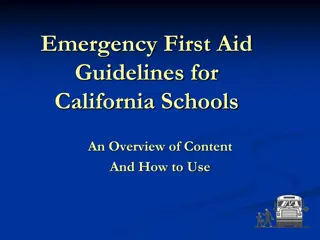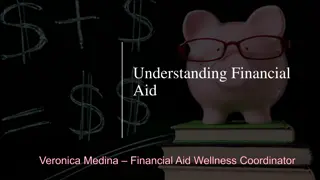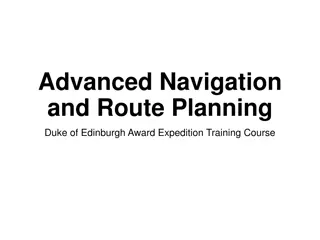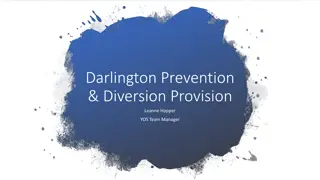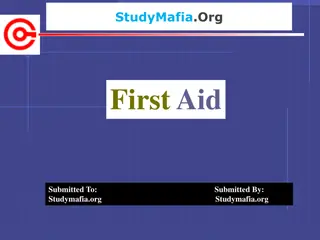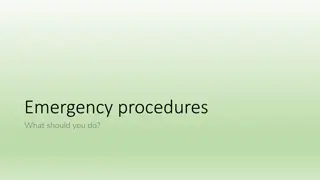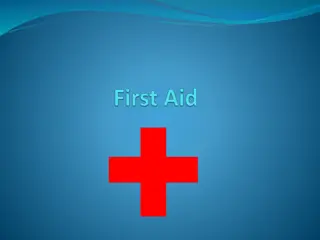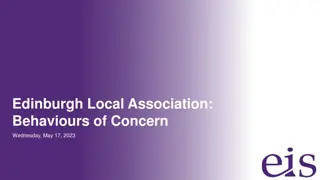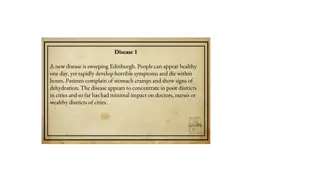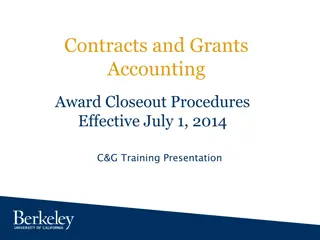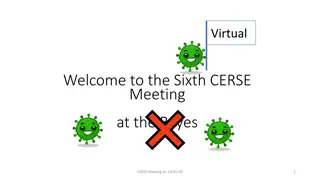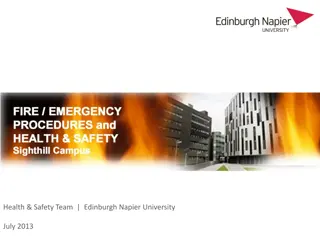First Aid and Emergency Procedures for Duke of Edinburgh Award
First aid and emergency procedures are essential for Duke of Edinburgh Award expeditions to handle potentially risky situations and injuries. Learn how to stay calm, assess emergencies, and act accordingly. Remember who to call in emergencies, prioritize safety, and follow protocols for assessing casualties. Stay prepared and equipped for safety during expeditions.
Download Presentation

Please find below an Image/Link to download the presentation.
The content on the website is provided AS IS for your information and personal use only. It may not be sold, licensed, or shared on other websites without obtaining consent from the author.If you encounter any issues during the download, it is possible that the publisher has removed the file from their server.
You are allowed to download the files provided on this website for personal or commercial use, subject to the condition that they are used lawfully. All files are the property of their respective owners.
The content on the website is provided AS IS for your information and personal use only. It may not be sold, licensed, or shared on other websites without obtaining consent from the author.
E N D
Presentation Transcript
First aid and emergency procedures Duke of Edinburgh Award Expedition Training Course
Introduction First Aid and emergency procedures provide a framework on how to approach a potentially dangerous or risky situation and, or when someone is hurt. This will help you stay calm, make safe choices and reduce the time it takes for help to arrive. Mostly injuries on a Duke of Edinburgh expedition are minor: cuts and grazes, blisters and minor burns. We however have to be prepared, but don't be scared by the First Aid training. You are not expected to be an expert First Aider. It will help you identify a possibly illness or injury and act in a way that helps a casualty.
Who to call Remember your supervisor will be able to deal with most emergencies. Call your supervisor first. BUT If there is a life-threatening situation or a crime in progress you must not hesitate to call 999, then contact your supervisor. We do not want to waste the time of our emergency services, but, if the call is necessary, make it.
Stay safe Personal safety, your team and safety of other countryside users should be foremost in your mind when planning your expedition. The safety and advice provided by the DofE can be download here. Plan for safety. Prepare escape routes and alternative routing, allowing for bad weather. Know the weather forecast and emergency procedures, before setting off. Equip for safety. Have the properly equipment and personal clothing, making sure it is being used or worn correctly. Do not carry too much and carry a personal first aid kit. DofE recommended kit can be found here. Find out how to use your first aid kit here. Train for safety. Follow the instructions and advice given to you throughout your training. Most accidents are avoidable. Prevention is better than cure, meaning taking steps to prevent an accident is better than having to deal with it.
What to do in an emergency or accident? A Duke of Edinburgh expedition isn't risk-free and it is important that you know what to do. Remember it may not be your team, but a member of the public who needs help. The most important piece of advice is to stay calm. Assess using the 3 S's. Is it Safe? What can you See? What is the Situation or what has happened? Make an area safe. It is important to eliminate anything that presents a danger to those involved and anyone who goes to help, including you, if it is safe to do so. Once an area is safe, use the primary survey to assess casualties. Assist the emergency services. Give the emergency services as much information as you can when they arrive. Follow their instructions.
DR ABC (or the primary survey) DR ABC is a really useful acronym when faced with an accident or emergency. It will help you assess any casualties, treating those most in need first. D = Danger. Always make sure the area is safe before attending to the casualty. R = Response. Check if the casualty is responsive or unresponsive. A = Airway. Check their airway is open and A person in a blue shirt Description automatically generated clear. B = Breathing. Check if they are breathing normally. C = Circulation. Check for signs of severe Click to watch the video. bleeding.
How to treat a severe wound or bleeding Severe bleeding can be dramatic and distressing. It is therefore important to stay calm, helping you think clearly and keep the casualty calm. A person sitting in a chair Description automatically generated Severe bleeding can be life- threatening. Click to watch the video.
How to treat shock Shock - not emotional shock - is a life-threatening A close up of a person Description automatically generated condition, caused by anything reducing the flow of blood, so oxygen is not reaching the body's vital Click to watch the video. organs.
The recovery position Putting a casualty into the recovery position will not improve a casualty's condition, but it does keep the airway clear and prevent choking as vomit and fluids drain out of the mouth. Only an unconscious casualty, breathing normally should be put into the recovery position. Click to watch the video. A casualty in the recovery position should be continually monitored.
How to do CPR Do not carry out CPR unless you have gone through DR ABC. CPR should only be used when a casualty has stopped A picture containing young, man Description automatically generated breathing or irregular breathing, called agonal breathing. Dial 999 or 112 for an ambulance. Essentially it is then 30 chest compressions and 2 rescue breaths until the ambulance arrives. Click to watch the video. There is a separate video for a child. Where possible work in teams of two as this is physically tiring.
How to treat hypothermia and heatstroke Being too cold and too hot can be life-threatening. Hypothermia is a condition that occurs when a casualty s body temperature drops below normal. Watch this video on how to treat hypothermia. It is a condition affecting many older people. Heatstroke is the opposite condition, when a casualty's brain stops regulating the body s temperate and is unable to cool itself. Watch this video on how to deal with heatstroke. Heatstroke also happens after heat exhaustion. This video shows you have to deal with heat exhaustion, hopefully preventing the worse condition of heatstroke developing.
General advice in hot weather The general advice in the hot weather is to cover up with light clothing, wear a hat, keep to the shade where possible, apply sun cream regularly and drink plenty of water. A DofE Expedition is not the time to 'top up your tan'. Sunburn also needs treating. Watch this video to find out how.
Asthma attack Asthma is a common lung condition, affecting someone's breathing. The air passages of A picture containing man, sitting, young, holding Description automatically generated a casualty become inflamed, possibly triggered by an irritant such as an allergy or just at random, causing the airways to narrow. Click to watch the video. Being unable to breathe can be a frightening experience.
Severe allergic reaction An allergen is a substance that causes the body to react in an abnormal way. Hayfever for example is a body's A picture containing man, young, standing Description automatically generated response to pollen. Some one in your team probably has an identified allergic reaction, for example to nuts and carries an epipen. Being outdoors however increases the chances of being exposed to an allergen. Click to watch the video. A severe allergic reaction is called an anaphylactic shock.
How to treat fractures and dislocated joints. A fracture is a break or a crack in a bone. If it is an open fracture, breaking through the skin there will be bleeding. A closed fracture, when the skin remains intact can A picture containing person, man, standing, holding Description automatically generated cause internal bleeding and possibly shock. Dislocated joints happen when bones are pulled out of their normal position. DO NOT ATTEMPT TO PUT THE BONE BACK as this can cause further damage. Instead support the bones as much as possible to Click to watch the video. stop it and get the casualty to hospital. A casualty may go into shock.
How to treat strains and sprains Strains and sprains are stretches or tears of the soft tissues between bones. The treatment is the same as demonstrated in the A picture containing man, person, young, holding Description automatically generated video. Remember the acronym RICE. Rest stop any activity and avoid putting weight on it. Ice apply an ice pack. Click to watch the video. Compression wrap a bandage around it. Elevate keep it raised as much as possible.
How to treat burns and scalds A burn is caused by dry heat - hot objects, fire, electricity - and a scald by wet heat: hot liquid or steam. The longer the contact, the more skin damage and remember your DR ABC. A person standing posing for the camera Description automatically generated Burns and scalds can be awful, depending on the 'thickness' of the wound. Click to watch the video.
How to treat cuts, grazes and splinters. A cut is when the skin is fully broken, whereas only the top layers of skin are scrapped away. Most cuts and grazes can be treated with the contents of A picture containing person, man, standing, holding Description automatically generated a basic first aid kit. Splinters of wood, glass and metal can usually be removed using tweezers. Again only if the splinter is deeply embedded or difficult to take out Click to watch the video. might a casualty need to seek medical help.
Blisters Blisters are small pockets of fluid underneath the skin, looking like fluid- filled bumps. They are caused by A picture containing food, drawing Description automatically generated constant rubbing or exposure to heat. Watch the video to find out ways to prevent blisters, the preferable option. In addition the video describes how to Click to watch the video. treat a blister. It is also advisable to include special blister plasters in your first aid kit.
How to treat stings and bites. It is better to prevent stings and bites than treat a bite. Regularly apply bite protection creams and sprays, wearing long sleeves and trousers and avoiding areas where stinging and biting insects gather, such as water. Ticks, a spider-like insect, living in woods and long grass, feeding off animal and human blood is particular problem. The video shows you how to remove a tick. Ticks spread serious diseases. Further information from the DofE is available here. A picture containing animal Description automatically generated Generally bites can be treated by removing the Click to watch the video. sting, tick or hairs if still in the skin. Wash the area and apply a cold press. Avoid scratching the sting or bite or any blisters to prevent infection.
How to treat a headache. Most headaches are easily treated, although it is useful to identify why a casualty might have a headache, for example, has s/he been drinking water regularly and therefore could be dehydrated. A headache after a head injury is of concern, particularly if it is getting worse. This is a sign of compression. Click to watch the video. On expedition, let your supervisor know if you have taken any medication, no matter how routine or trivial it seems to you.
Summoning help Download the DofE safety and advice card here, if you haven't already. Your supervisor must remain in the area at all times and your supervisor can help in most situation. If emergency assistance is required, dial 999 immediately and then contact your supervisor. Alternatively two members of the team could be sent for help. Make sure instructions are clear and that the two members are given the second map, compass, emergency mobile phone and emergency phone procedures. Help maybe available at the nearest house or from other countryside users. Don't be afraid to ask.
Calling 999 or 112 If someone is seriously ill or injured and a life is at risk, do not hesitate to call 999. This might be the first time you have dialled 999 and the video explains what to expect. Work as a team. Often having something to do helps everyone stay calm and feel a sense of control. A picture containing indoor, monitor, black, sitting Description automatically generated Be ready to provide the following: 1. The telephone number you are calling from. 2. The exact location of the incident. 3. The type and gravity of the emergency. 4. Number, gender and age of casualties. 5. Details of any hazards. Click to watch the video.
What to do while you are waiting? There is a lot you can do while waiting for your supervisor or the emergency services. Again work as a team. Often having something to do helps everyone stay calm and feel a sense of control. Make the casualty more comfortable perhaps put up the tent to create a shelter. Continue to monitor them. Record what has happened. Make it easier for your supervisor or emergency services to find you. Take out hi-visibility clothing or bright rucksack covers. Form a chain to the nearest road.
Self-assessment Take a moment to reflect on your understanding of this course. Confident. Take the test and see where you need to improve, if at all. Not confident. Work through the material again, do some extra research or ask an adult for help. Take the test and see where you need to improve.
